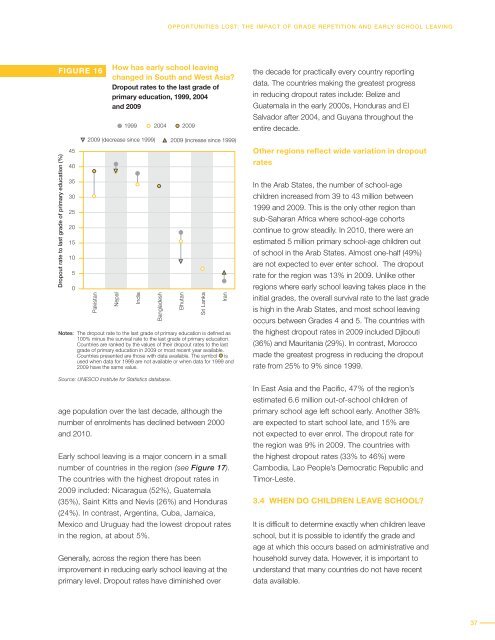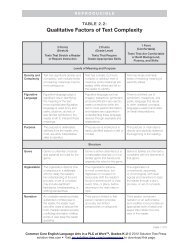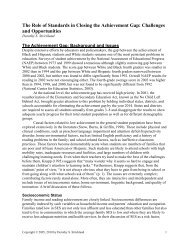Global Education Digest 2012 - International Reading Association
Global Education Digest 2012 - International Reading Association
Global Education Digest 2012 - International Reading Association
Create successful ePaper yourself
Turn your PDF publications into a flip-book with our unique Google optimized e-Paper software.
OPPORTUNITIES LOST: THE IMPACT OF GRADE REPETITION AND EARLY SCHOOL LEAVING<br />
FIGURE 16<br />
Dropout rate to last grade of primary education (%)<br />
45<br />
40<br />
35<br />
30<br />
25<br />
20<br />
15<br />
10<br />
5<br />
0<br />
age population over the last decade, although the<br />
number of enrolments has declined between 2000<br />
and 2010.<br />
2009 (decrease since 1999) 2009 (increase since 1999)<br />
Pakistan<br />
Nepal<br />
India<br />
Early school leaving is a major concern in a small<br />
number of countries in the region (see Figure 17).<br />
The countries with the highest dropout rates in<br />
2009 included: Nicaragua (52%), Guatemala<br />
(35%), Saint Kitts and Nevis (26%) and Honduras<br />
(24%). In contrast, Argentina, Cuba, Jamaica,<br />
Mexico and Uruguay had the lowest dropout rates<br />
in the region, at about 5%.<br />
How has early school leaving<br />
changed in South and West Asia?<br />
Dropout rates to the last grade of<br />
primary education, 1999, 2004<br />
and 2009<br />
1999 2004 2009<br />
Notes: The dropout rate to the last grade of primary education is defined as<br />
100% minus the survival rate to the last grade of primary education.<br />
Countries are ranked by the values of their dropout rates to the last<br />
grade of primary education in 2009 or most recent year available.<br />
Countries presented are those with data available. The symbol is<br />
used when data for 1999 are not available or when data for 1999 and<br />
2009 have the same value.<br />
Generally, across the region there has been<br />
improvement in reducing early school leaving at the<br />
primary level. Dropout rates have diminished over<br />
Bangladesh<br />
Source: UNESCO Institute for Statistics database.<br />
Bhutan<br />
Sri Lanka<br />
Iran<br />
the decade for practically every country reporting<br />
data. The countries making the greatest progress<br />
in reducing dropout rates include: Belize and<br />
Guatemala in the early 2000s, Honduras and El<br />
Salvador after 2004, and Guyana throughout the<br />
entire decade.<br />
Other regions reflect wide variation in dropout<br />
rates<br />
In the Arab States, the number of school-age<br />
children increased from 39 to 43 million between<br />
1999 and 2009. This is the only other region than<br />
sub-Saharan Africa where school-age cohorts<br />
continue to grow steadily. In 2010, there were an<br />
estimated 5 million primary school-age children out<br />
of school in the Arab States. Almost one-half (49%)<br />
are not expected to ever enter school. The dropout<br />
rate for the region was 13% in 2009. Unlike other<br />
regions where early school leaving takes place in the<br />
initial grades, the overall survival rate to the last grade<br />
is high in the Arab States, and most school leaving<br />
occurs between Grades 4 and 5. The countries with<br />
the highest dropout rates in 2009 included Djibouti<br />
(36%) and Mauritania (29%). In contrast, Morocco<br />
made the greatest progress in reducing the dropout<br />
rate from 25% to 9% since 1999.<br />
In East Asia and the Pacific, 47% of the region’s<br />
estimated 6.6 million out-of-school children of<br />
primary school age left school early. Another 38%<br />
are expected to start school late, and 15% are<br />
not expected to ever enrol. The dropout rate for<br />
the region was 9% in 2009. The countries with<br />
the highest dropout rates (33% to 46%) were<br />
Cambodia, Lao People’s Democratic Republic and<br />
Timor-Leste.<br />
3.4 WHEN DO CHILDREN LEAVE SCHOOL?<br />
It is difficult to determine exactly when children leave<br />
school, but it is possible to identify the grade and<br />
age at which this occurs based on administrative and<br />
household survey data. However, it is important to<br />
understand that many countries do not have recent<br />
data available.<br />
37

















